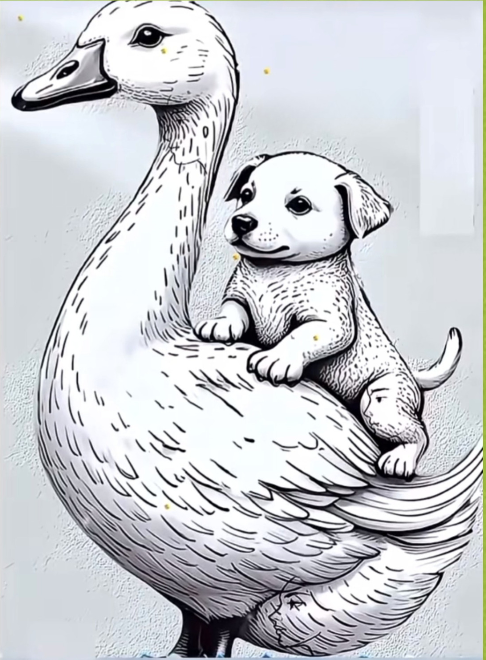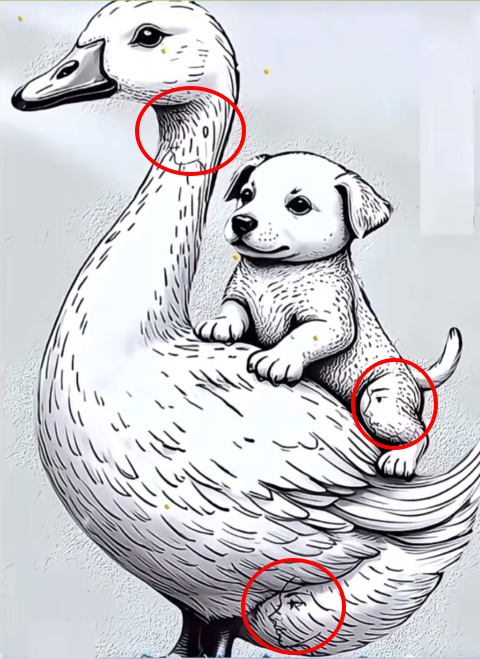Unmasking Hidden Faces: The Goose‑and‑Puppy Optical Illusion Revealed
The Allure of Visual Illusions and Pareidolia
Have you ever glanced at an image and suddenly “seen” a face in the clouds or a figure in a tree’s bark? That phenomenon—called pareidolia—hijacks our brains’ powerful face‑recognition circuitry, prompting us to find familiar patterns where none truly exist. Artists and puzzle‑makers have long exploited this quirk to craft captivating optical illusions, and the charming scene of a puppy hitching a ride on a proud goose is no exception. Beneath its sweet surface, this illustration hides multiple human profiles waiting to be uncovered. Ready to sharpen your perception and delight in each “Aha!” moment? Let’s dive in!

Meet the Goose‑and‑Puppy Puzzle
At first blush, you see a gentle goose standing tall, its neck gracefully curving skyward. Perched atop its broad back is an eager little puppy, paws gripping feathers as it peers into the distance. Rendered in crisp black‑and‑white lines, the scene feels both whimsical and serene—a vintage‑style drawing that invites closer inspection. But look again: seams, shadows, and feather strokes double as eyebrows, noses, and lips. Each clever contour conceals a miniature human face, camouflaged within the animal forms.
Why Our Brains Are Wired to See Faces
Evolution favored anyone who could spot a predator’s gaze or a fellow tribe member’s expression halfway across a clearing. That urgency to detect faces runs so deep that today, we still scan random visuals for familiar features. Spotting a hidden face in a cloud or leaf patch triggers a mini dopamine rush—our brain’s way of high‑fiving itself for a successful pattern match. Optical illusions tap into this reward system, providing simple yet profound pleasure as we uncover each secret profile.

Face‑Finding Strategies: How to Reveal Every Profile
Even the keenest eyes benefit from a plan. Use these tactics to ensure you spot all the human faces in our feather‑and‑fur tableau:
- Divide and Conquer
Mentally split the image into three zones—head/neck, body, and tail/legs. Focus on one area at a time to avoid feeling overwhelmed. - Follow the Contours
Trace the outlines of the goose’s neck, back, and wings with your finger. What looks like a feather edge could be a forehead or a chin. - Hunt for Eyes First
Human faces typically feature two eyes equidistant on a horizontal line. Scan for small ovals or dark dots that might form a pair. - Zoom In and Out
If you’re on-screen, alternate between magnified and full‑image views. Detailed lines reveal subtle cues up close, while stepping back helps faces coalesce from the larger pattern. - Take Micro‑Breaks
Staring too long at the same spot fatigues your vision. Look away for ten seconds, then return—fresh perspectives often highlight previously missed profiles.

Counting the Hidden Faces: A Step‑by‑Step Guide
Let’s embark on the face‑finding adventure together. Here’s a typical tour uncovering eight distinct profiles:
- Primary Goose Face
Of course, the goose itself appears as a large face, beak as nose, eye as eye. - Puppy’s Ear Profile
Look at the curve of the puppy’s ear—within that arch you’ll spot a child‑like face, forehead to chin. - Neck‑Feather Silhouette
Along the neck’s back, a series of feathered strokes outlines a side‑view profile, complete with nose ridge formed by a bold line. - Body‑Contour Face
On the goose’s flank, curving shading lines converge to form lips and a chin under an implied brow line. - Wing‑Pattern Persona
Partway down the wing, the feather patterns sketch another profile, eyes appearing as pairing feather dots. - Leg‑Joint Impression
The fold at the joint where leg meets body subtly crafts a cheek and jawline of a hidden character. - Tail‑Tip Trickster
At the wingtip’s end, overlapping feathers give birth to a final face—almost camouflaged until you know what to look for. - Puppy‑Back Surprise
Lastly, on the puppy’s back or paw area, fine fur lines sometimes resolve into a tiny silhouette you might have missed.
Each discovered visage feels like unlocking a secret door in the image—proof of your brain’s incredible pattern‑recognition power.

Cognitive Benefits of Visual Illusions
Engaging with puzzles like this does more than delight—it strengthens essential mental muscles:
- Enhanced Attention to Detail
Training your eyes to catch minute shape shifts helps in everyday tasks: proofreading emails, mastering crafts, or noticing subtle social cues. - Improved Visual Memory
Recalling where you’ve already searched reinforces short‑term memory circuits, useful for remembering names, faces, and to‑do lists. - Boosted Problem‑Solving Skills
Adapting your search approach—switching strategies when one fails—mirrors the flexible thinking needed for work or personal challenges. - Stress Reduction
Focusing on a simple yet engaging task calms the mind, offering a meditative escape from daily worries and reducing cortisol levels.
Beyond the Illusion: Creative and Educational Uses
Hidden‑face puzzles can enrich classrooms, family game nights, or creative workshops:
- Art Education
Students studying line, shading, and form can explore how minimal strokes evoke face recognition—bridging art and psychology. - Team‑Building Exercises
Colleagues working in pairs to find profiles fosters collaboration and lighthearted competition, perfect for office retreats. - Therapeutic Tools
Therapists sometimes use visual puzzles to enhance focus and mindfulness in clients coping with anxiety or ADHD. - Custom Puzzle Creation
Feeling inspired? Sketch your own stack of animals or everyday object collage and sneak in hidden faces. Share with friends for a personalized brain‑teaser exchange.

Conclusion: Revel in the Joy of Discovery
The simple scene of a puppy astride a goose transforms into a playground for your perception, where human profiles emerge from feathered lines and fur textures. By tapping into pareidolia, applying systematic strategies, and savoring each find, you hone attention, boost memory, and indulge in genuine delight. Whether you uncovered eight faces or spotted even more, the real win lies in the journey—celebrating what our minds can achieve when we look closely and playfully. So next time you encounter an intriguing illustration, remember: with a curious eye and a patient heart, hidden wonders await your discovery. Happy face‑finding!